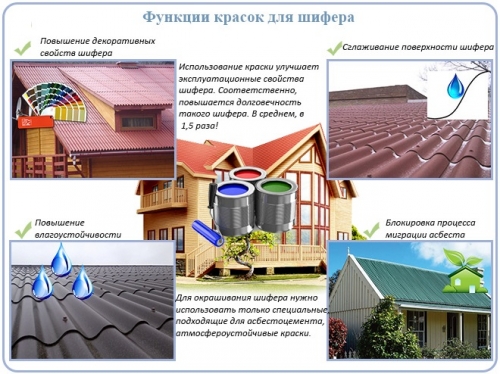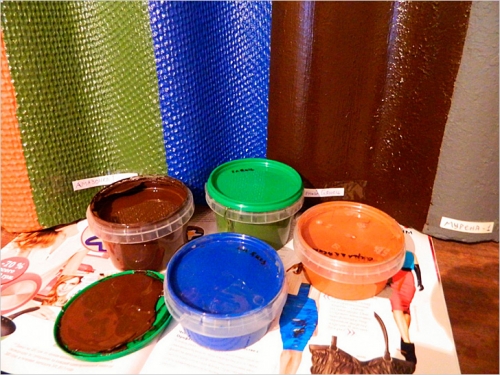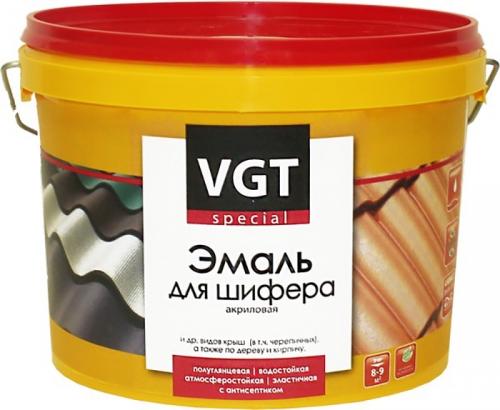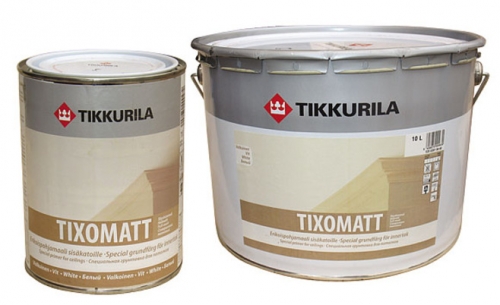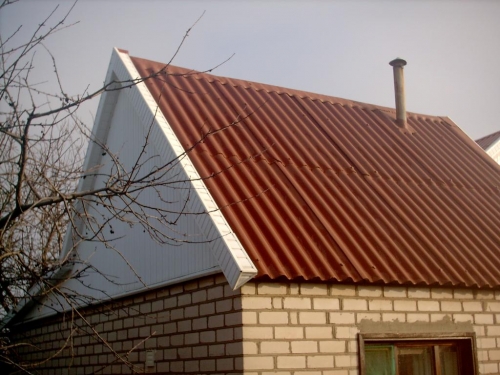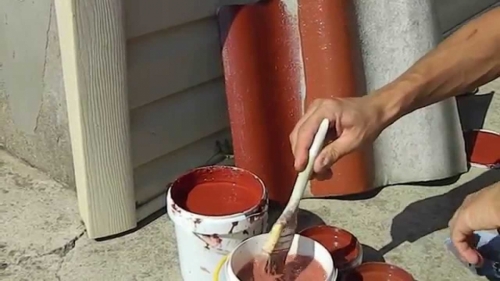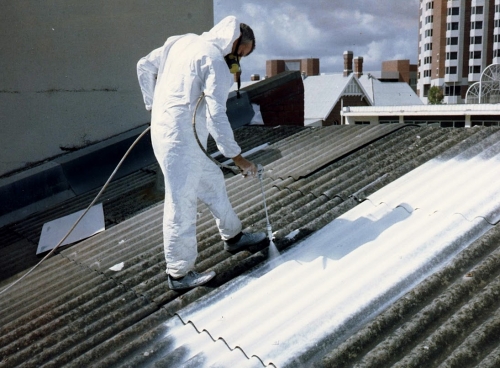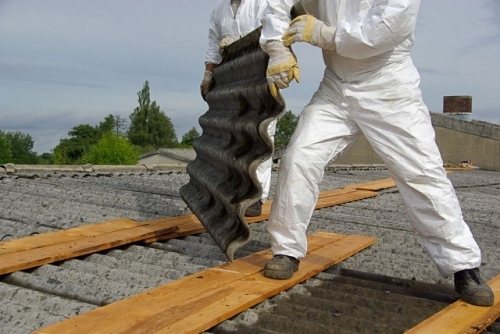The need to raise the floor level in the apartment may be due to various ...
|
|
A rather popular building element is considered a plastic window ... |
In Khrushchevs and other buildings of the Soviet era, low problems are considered a big problem ... |
Acrylic paint coating with your own hands
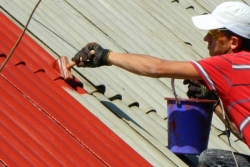
The operation of the asbestos-cement slate reaches 50 years. However, with proper care, the life of the roofing material can significantly increase. One of the mandatory conditions for the durability of the slate is its painting. As a result of staining, a protective layer is formed on the surface, and the roof itself acquires an attractive appearance.
- Do I need to paint the slate?
- Which paint is better to paint slate: the advice of choosing
- With your own steps painting with your own hands
- Calculation of the volume of paint
- Surface preparation
- Shifer painting technology
- Practical recommendations of specialists
- Features of painting a new and old slate
Do I need to paint the slate?
Asbestos -cement slate for a long time was considered the most popular option for arranging a roof due to its good operational characteristics and price availability. And today, many prefer this particular material when erecting buildings for various purposes.
Simple installation and inexpensive slate has some disadvantages:
- not attractive appearance;
- a tendency to develop a lichen, moss;
- a gradual decrease in the strength characteristics under the influence of weather conditions and external factors.
Slate porous material predisposed to the appearance of microcracks. Moisture accumulated in the pores, in the first frosts, turns into ice and gradually breaks the material from the inside. The same deformations are inevitable when growing on the surface of lichens and mosses.
The listed problems will help solve the painting of asbestos slate. After staining on the surface of the roof, a strong film is formed, covering access to water and microorganisms. As a result, the destruction processes are suspended, and the service life of the slate is extended by several years.
Thanks to the protective layer, the slate becomes smooth, atmospheric moisture on it is not held, and the snow and fallen leaves quickly go away. Accumulated pollution can easily be washed off with a minimum for a car or a water under pressure from a summer cottage.
In addition, painting is solved by another issue of the theoretical harmfulness of the slate. This version is mainly distributed by manufacturers of advanced and expensive roof materials. The essence of the problem is that the slate coating emits asbestos dust, which has a negative effect on the ecology and health of people. There are numerous refutations of such a version. However, for doubters, there is an optimal solution to a slate, which will completely prevent the output of asbestos dust.
So, painting the slate roof allows:
- improve the appearance of the roof and betray the desired color to it;
- smooth out the roughness of the slate;
- prevent the formation of cracks;
- protect the material from the growth of vegetation on it;
- prevent dusting;
- increase the life of the roofing material by 1.5 times.
Which paint is better to paint slate: the advice of choosing
The slate paint must comply with many requirements. The main selection criteria: resistance to temperature fluctuations, burnout and atmospheric precipitation. An important indicator level of adhesion with asbestos -cement.
The following LKM groups are used for staining the slate:
- acrylic enamels;
- alkyd;
- silicon;
- Liquid plastic.
The most popular acrylic compositions. They are distinguished by saturated tones of various matters. Types of acrylic enamels: water -soluble or on organic solvents.
Water-dispersed acrylic paint for slate has a number of advantages:
- lack of pungent odor;
- fire and explosion-proof thanks to water-based;
- does not emit toxic substances;
- in the process of application does not need a special solvent;
- drying speed of about 2 hours;
- the formation of a waterproof film;
- the coating service period is 5 years.
Water -soluble acrylic paints of the following manufacturers have established themselves well:
- Alpina DachFarbe (Caparol) enamel of green, brown or red, resistant to frost and weather conditions.
- The roofing paint according to the slate (Novytkhim) forms a matte coating, resistant to the development of microorganisms. It is produced in five colors.
- The AK-1SH AKVAGEL (Styrol) LKM creates a smooth film on the slate, with which water quickly flows. A distinctive feature of the ease of care for the roof.
Latex paintA variety of acrylic paintwork on water -based. It looks like a thick mastic, and after drying it is converted into a flexible, elastic film. Such a rubber coating does not crack, does not pass water and has excellent adhesion with slate. From the color scheme the most in demand for the acrylic shifer 6005 (green matte), 5005 (blue matte) and 3009 (red-brown matte) is most in demand. Nomenclature of flowers according to RAL.
Acrylic enamels on organic solvents differ:
- higher strength than water -soluble paints;
- elasticity;
- high water -repellent characteristics;
- light resistance;
- a longer drying deadline for about ten hours;
- caustic smell;
- moderate toxicity and fire hazard.
Important! If the organic acrylic paint is too thick, then it must be diluted with the solvent that is part of the enamel. Coloring work should be performed away from open flames using individual protection.
Alkyd slate paintsthey quickly dry and form an elastic film on the roofing material that is not inclined to the appearance of cracks. The additional advantages of alkyd enamel include:
- high coupling with slate;
- good moisture resistance;
- resistance to natural phenomena;
- before painting, it is not necessary to primer the surface;
- the life of at least 5 years.
Examples of high -quality alkyd paint:
- Quick -dry enamel (pulse) rapid drying (for 1 hour at an ambient temperature of 20C), lack of a pungent odor.
- Roof enamel (Empils) The strength of the protective layer, 10 colors.
Silicone paintsThe most durable and reliable option for painting the roof. Silicon betrays the enamel of elasticity. Some types of silicon paints can fill microcracks with a thickness of up to 2 mm.
Important! Silicone enamel is the best option for processing an old roof.
Quality characteristics of silicone colors:
- high elasticity;
- the possibility of performing the restoration of the roof and shallowing cracks;
- fungicidal qualities block the propagation of microorganisms;
- excellent dirt and water-repellent characteristics;
- silicones are fireproof and non -toxic;
- durability is the service life of up to 15 years.
Examples of high -quality silicone enamels:
- Co-shifer (silicolin) forms a deep color and strong coating, is produced in two primary colors with the possibility of tinting;
- OS-5103K (siliconolmer) is used for decorative protective painting of various building materials. It is characterized by increased resistance to chemical gases, an alkaline and acidic environment. Thanks to such characteristics, paint can be used at industrial enterprises.
Polymer paints A plastic film of matte or glossy texture is formed on the surface of the material.
Quality indicators of liquid plastic:
- 100% moisture resistance. Polymer film does not allow moisture to seep to slate;
- drying speed;
- harmlessness for ecology and lack of danger of fire;
- resistance to UV rays;
- the possibility of applying silicone enamel without the use of a primer of deep penetration;
- it is permissible to apply enamel in frosty weather (up to -10C);
- durability is about 15 years.
Options for good polymer paint:
- Liquid Plastic (Denalt) is available on a polyurethane-alkable base, which gives the coating sufficient strength;
- PPG-1 (mockery) contains polystyrene. In the process of drying, a strong layer protecting from moisture is formed.
Important! Polymer paints dry very quickly. Therefore, staining is desirable to perform with a spray gun.
With your own steps painting with your own hands
Most often, slate is painted with acrylic paints. Therefore, we will analyze the order of work using this type of enamel.
Calculation of the volume of paint
LKM consumption depends on the covered area and the absorption of the material. As a rule, for staining 1 sq.m. The slate is spent about 300 gr. paints. To determine the overall liter of enamel, the roof area must be calculated.
The procedure for calculating the area of \u200b\u200bthe gable roof:
- Measure the length and width of the building. Data is taken taking into account allowances for cornices (about 50 cm).
- Calculate according to the formula: s \u003d 2*(a*b), where s desired roof area, and the length of the roof is, b length of the roof.
The resulting value should be multiplied by the average enamel consumption. When determining the total volume of paint, it must be borne in mind that for high -quality staining, two layers will have to be applied.
Surface preparation
The longest and laborious stage is the preparation of the surface for painting. The complex of events includes:
- Careful cleaning of slate. Using a hard brush or scraper, remove moss, lime and dirt from the surface of the roof. To accelerate the process, you can use the car wash under pressure.
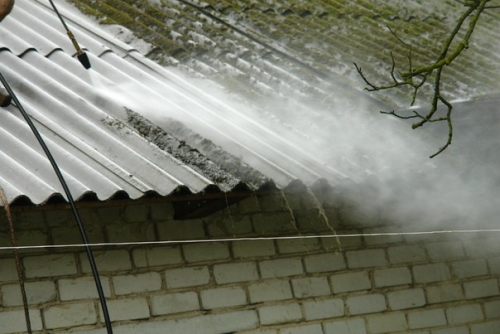
- Treatment with an antiseptic solution will allow you to get rid of parasites that have penetrated the pores of the slate. You can use gasoline, general -purpose antiseptic. Apply the composition evenly over the entire area of \u200b\u200bthe roof and leave until completely dry. It is optimal if the slate after gasoline treatment will flow out before the moment of staining.
- The surface primer will strengthen porous material, improve adhesion with paint and protect the roof from the growth of algae, mosses, etc. The slate is treated before painting deep penetration through the sprayer. Recommended air temperature from 5C to 30C.
Important! The application of paint on the slate should be proceeded only after the primer layer dries after at least 12 hours.
Shifer painting technology
It is advisable to prepare brushes of different sizes in advance in order to qualitatively process the ends, corners and hard -to -reach places of the roof. The paint is applied with two layers of the main and finish.
Important! It is permissible to paint a flat slate using a sprayer. When processing wavy material, it is better to refuse to eat the risk of uneven staining.
The main layer is applied with special attentiveness, capturing all areas from top to bottom. After that, the base coating must be left completely dry and paint re -applied.
The finish layer evens out sharp transitions of the paint and creates a plain, rich color of the roof.
Practical recommendations of specialists
- It is necessary to take care of the safety of high -rise work in advance, and prepare the safety belt. When spraying the primer and paints, it is necessary to put on protective glasses and a respirator.
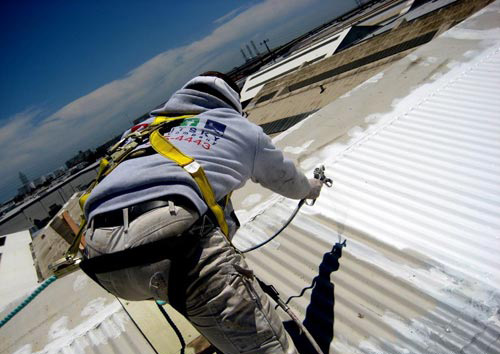
- After applying the first layer to dry the surface, it is necessary to leave more time than indicated on the enamel packaging. Often the instructions indicate the terms under the most favorable conditions.
- A qualitatively primed surface significantly saves paint, reducing its consumption.
- It is better to paint a flat slate with your own hands in the absence of spraying equipment with a roller, not a brush.
- Optimal weather conditions for staining: a calm day with an air temperature 13-17C. When planning the painting of the roof, you need to know the weather forecast for a week in advance, the longer there are no rains, the more durable the coating will be.
- It is advisable to entrust the roofs of the roofs of complex configurations to professionals. It is better to paint a simple gable roof together with an assistant.
Features of painting a new and old slate
It is better to paint a new slate below - before laying the roof. There is an opinion that the base layer should be applied on the ground, and the finish after the installation of the slate. Supporters of this method argue their opinion by possible damage to enamel when installing sheets. However, many experts believe that the risk of stripping a layer of paint is primarily associated with unprofessionalism of workers and the complexity of the design of the roof itself. It is much easier to paint over local scratches at the top than to apply a completely layer of paint.
The old slate is more complicated in processing due to a number of factors:
- Detection of the structure. Elements of the crate over time are weakened and bend. Walking on the roof can lead to the appearance of cracks on the slate.
- Partial destruction of roofing material. Before dyeing the old slate, you need to check it for defects. Replace unbearable sheets, and repair minor breaks.
- Changing the structure of slate coating. Under the influence of precipitation and temperature changes, the material becomes loose, this creates a danger to workers performing the staining of slate.
- The need to clean the surface from accumulated dirt and various growths.
Thanks to modern painting materials, it will be possible to avoid the dullness and grayness of the slate. The main thing is to choose the right paint and adhere to the technological process, then the result will delight for many years.
DIY shifer painting: video

